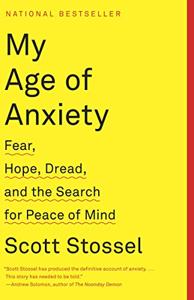
Want to learn the ideas in My Age of Anxiety better than ever? Read the world’s #1 book summary of My Age of Anxiety by Scott Stossel here.
Read a brief 1-Page Summary or watch video summaries curated by our expert team. Note: this book guide is not affiliated with or endorsed by the publisher or author, and we always encourage you to purchase and read the full book.
Video Summaries of My Age of Anxiety
We’ve scoured the Internet for the very best videos on My Age of Anxiety, from high-quality videos summaries to interviews or commentary by Scott Stossel.
1-Page Summary of My Age of Anxiety
Overview
Most of us experience anxiety from time to time, but it doesn’t usually get in the way of leading a normal life.
Those who suffer from clinical anxiety are scared of things that aren’t intrinsically dangerous (like public speaking), and have extreme reactions to them, such as vomiting or fainting.
In this article, you will learn about the theories on anxiety, how people who are clinically anxious can have problems with certain tasks that seem easy for others. You’ll also read about embarrassing situations where the author became anxious and couldn’t do simple things like using a bathroom at John F. Kennedy’s home.
Big Idea #1: Clinical anxiety is the most common form of mental illness.
Most people would agree that anxiety is fairly normal. However, few are aware that clinical anxiety is the most common type of mental illness and one out of six will experience it for at least a year in their lifetime. It seems to be a characteristic that defies the boundaries of both culture and time as well; Spanish-speaking South America calls it “ataques de nervios,” Greenland Inuit call it “kayak angst” and Iranians talk about “heart distress.” Despite these differences, however, all refer to a common state.
Anxiety is a serious problem throughout the world, and it’s not limited to any particular time period. It has been discussed in many historical documents.
In the past, there were many different theories about anxiety. People like Plato and Hippocrates wrote about it. Freud was very interested in studying anxiety, as well as defining it. Anxiety is not a sign of weakness or character flaw but rather something positive that motivates civilization and creativity.
Many people who are known for their success and influence, such as Gandhi, Charles Darwin, Barbra Streisand and 40 million Americans have struggled with anxiety.
The author of this article is a successful journalist and editor, so he can provide for his family. Despite being diagnosed with anxiety disorder, the author has succeeded in life.
Anxiety is a universal illness that affects everyone. It’s what it’s like to live with anxiety and the symptoms of clinical anxiety.
Big Idea #2: Anxiety is a disease that makes one’s life hard, stressful and embarrassing.
Anxiety is similar to diabetes in that people with anxiety are constantly battling it. Just like diabetics have to monitor their blood sugar and inject insulin, the anxious must watch out for stressful situations and be prepared to handle them by dosing themselves with medication.
Anxiety can be limiting for people. It often keeps them from living a normal life and causes them to stay home because they feel safe there.
For example, one man was so anxious that he couldn’t walk around his neighborhood without vomiting blood. In addition, it’s impossible for the author to get on an airplane or speak in public without consuming a mixture of medication and alcohol.
Anxious people tend to get overly attached to their loved ones. For example, the author was very attached as a child and would call his parents’ friends when he couldn’t find them because he thought they had died.
Anxious people often struggle with unpredictable and embarrassing behavior. For example, when the author traveled abroad he visited many restrooms but didn’t see any sights because he was so anxious.
The author once had the opportunity to visit with the Kennedy family. Unfortunately, he ended up clogging their toilet and flooding the bathroom.
Big Idea #3: The cause of anxiety might be determined in childhood.
There are many theories about why people get anxious. There’s the psychoanalytic theory, which is based on the idea that anxiety comes from repressed feelings and thoughts that children have when they’re young. Freud believed that boys want to sleep with their mothers and hate their fathers, while girls want to sleep with their fathers and hate their mothers.





